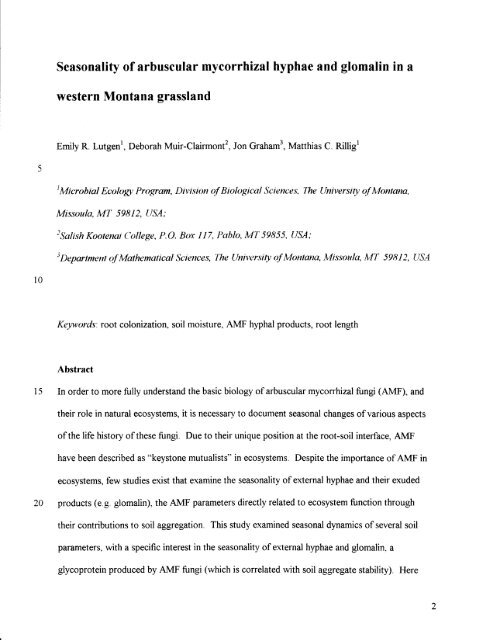Final Report - Center for Invasive Plant Management
Final Report - Center for Invasive Plant Management
Final Report - Center for Invasive Plant Management
You also want an ePaper? Increase the reach of your titles
YUMPU automatically turns print PDFs into web optimized ePapers that Google loves.
Seasonality of arbuscular mycorrhizal hyphae and glomalin in awestern Montana grasslandEmily R. Lutgenr, Deborah Muir-Clairmontz, Jon Graham3, Matthias C. RilligttMicrobial Ecolog; Program, Dilr.rlon of Biological S'ilelces., 7-he {hiversit-v- of A,{ontana,Missoula, MT 59812, {/SA:tSalish Kootenai College, I).O. Rox 117, Pablo,lvtT' 59555, USA:sDepartment af lu{athematicctl Sciences, 7-he (hir'{rsity af Montana, Missoula, MT 598}2, {iS.,ll0Kelnvords', root solonization, soil moisture, AMF hyphal products, root lengthAbstractt5In order to more fully understand the basic biology of arbuscular mycorrhizal fungi (AMF), andtheir role in natural ecosystems, it is necessary to document seasonal changes of various aspectsof the life history of these fungi. Due to their unique position at the root-soil interface, AMFhave been described as "keystone mutualists" in ecosystems. Despite the importance of AMF inecosystems, few studies exist that examine the seasonality of external hyphae and their exudedz0products (e.g. glomalin), the AMF parameters directly related to ecosystem function throughtheir contributions to soil aggregation. This study examined seasonal dynamics of several soilparameters, with a specific interest in the seasonality of external hyphae and glomalin" aglycoprotein produced by AMF fungi (which is correlated with soil aggregate stability). Here
















